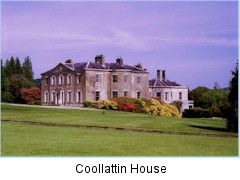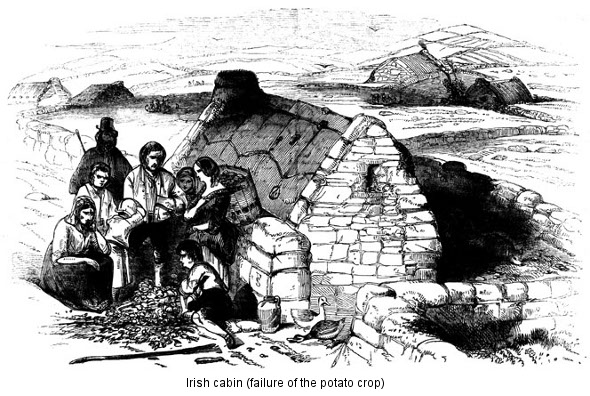Journal Volume 5 2006
Surplus People from Newcastle and Ballyvolan (continued/1)
The Fitzwilliam Estate
 By far the largest estate in County Wicklow was that owned by Earl Fitzwilliam, with Coolattin house near Shillelagh as its centre. The bulk of the estate covered the south-west corner of the county, but there were also outlying pockets further north and east, two of which were located at Newcastle and Ballyvolan. In the 1840s, the Fitzwilliam estate consisted of over 80,000 acres, spreading over more than a hundred townlands, and covering one-fifth of the entire county of Wicklow, with more than 20,000 tenants. By the end of the century it had grown to 90,000 acres. Fitzwilliam had two other estates in England, and he spent most of his time there. The day-to-day running of Coolattin was left in the hands of his agent Robert Challoner. By definition then, Fitzwilliam was an absentee landlord, but it would be unfair to ascribe to him the connotations of that description. Unlike the usual absentee, Fitzwilliam took a close interest in the management of his Irish properties and was remarkably well versed in their minutiae. Few decisions were made without his approval.2
By far the largest estate in County Wicklow was that owned by Earl Fitzwilliam, with Coolattin house near Shillelagh as its centre. The bulk of the estate covered the south-west corner of the county, but there were also outlying pockets further north and east, two of which were located at Newcastle and Ballyvolan. In the 1840s, the Fitzwilliam estate consisted of over 80,000 acres, spreading over more than a hundred townlands, and covering one-fifth of the entire county of Wicklow, with more than 20,000 tenants. By the end of the century it had grown to 90,000 acres. Fitzwilliam had two other estates in England, and he spent most of his time there. The day-to-day running of Coolattin was left in the hands of his agent Robert Challoner. By definition then, Fitzwilliam was an absentee landlord, but it would be unfair to ascribe to him the connotations of that description. Unlike the usual absentee, Fitzwilliam took a close interest in the management of his Irish properties and was remarkably well versed in their minutiae. Few decisions were made without his approval.2
For generations the Fitzwilliams were regarded as liberal landlords who believed that the welfare of the tenants was not only morally laudable but also made good business sense. They paid higher wages and charged lower rents than other employers and landlords in the region. They also ran a 'Poor Shop' which operated as a savings club. Tenants could save as little or as much as their circumstances allowed. In most cases, the savings were used to buy blankets and clothes from the shop at favourable rates.3
At a time when many landlords in Ireland would not allow Catholic churches to be built on their estates, the Fitzwilliams not only gave permission but in some cases donated land and contributed towards the cost of erecting the church. Schools - Catholic, Protestant, and mixed - were also encouraged and many were either wholly or partly maintained from the estate coffers. Deals were struck between tenants and the estate as to how much each would contribute to improvement projects such as drainage and the erection or expansion of houses or farm buildings.
Of the 80,000 acres only about 800 were worked by the estate staff. The rest were leased and rented out. This created a multi-tiered structure. For example, a well-to-do farmer might lease 500 or more acres from the estate. He might work 200 acres and sublet the other 300 to as many as ten, twenty or more subtenants. Some of these subtenants did the same thing, and at the bottom of the socio-economic ladder was the landless labourer who rented a cabin and a small plot of ground, seldom more than one acre, in which to grow potatoes. There could be as many as five strata of tenants and subtenants between the estate management and the landless labouring class. Those who leased direct from the estate were ‘head tenants’ and those in the intermediate strata were ‘middleman’ or ‘undertenants’. Sublessors made quite a profit by charging a much higher rent per acre than they themselves were paying. This meant that the poorest were paying the highest rent pro rata.
Although County Wicklow was economically better off than many other Irish counties, there was still a great deal of poverty among those on the bottom rung of the social ladder. In general, the land on the Fitzwilliam estate was poor and needed regular treatment with animal manure and lime. There was never enough of the former and the latter had to be brought from twenty miles away, making it costly. This drove many into debt to money lenders whose rates of interest could be as high as forty percent. When tenants and subtenants fell behind in rent, the immediate landlord, whether the estate or a middleman, usually obtained legal permission to 'distrain' the value, that is seize goods from the defaulter to the value of the rent owed. There was a fee for this legal permission which was added to the amount owed. This constant erosion of what little capital and goods smallholders might have amassed in rare good years made it impossible for them to improve their holdings. This general downward trend in the economy caused greatest hardship among the smallholders with between ten and fifty acres and increasing unemployment among the landless labourers.
In practice, the landless labourers seldom handled cash. They paid their rent in free labour, but with the demand for their services diminishing each year the poverty in which these people lived became horrific. According to a Roman Catholic priest on the Fitzwilliam estate in 1844, giving evidence before the Devon Commission (which was established to enquire into the state of land tenure and general social conditions in Ireland):
‘ … their condition is deplorable, and the lower order of people are famishing. I do not think that a great number of those who hold small farms under middlemen can afford themselves more than two meals each day constantly, and without milk or any other nourishment but their potatoes, and those potatoes are often sent a mile or two, and they eat them cold, and in the ditches: it is dreadful to consider the starvation they are subject to.’4
And that was the year before the major potato crop failures which heralded the Great Famine. Twenty-eight percent of families in County Wicklow lived in one-roomed stone or mud cabins, topped with the poorest thatch. The mud floor had no covering.

The staple diet for the vast majority of these people was potato and buttermilk. This wasn't as bad as it sounds because not only was the potato highly nutritious, but it could be grown easily and abundantly on small plots of ground. It was a wonder food. Unfortunately, it was also highly prone to disease. Seldom a year went by without a localised outbreak of blight. Seldom a decade passed without a widespread crop failure. Even in good years, there were the annual 'hungry months' between the last of the old crop being consumed and the harvesting of the new. It was life by brinkmanship.


